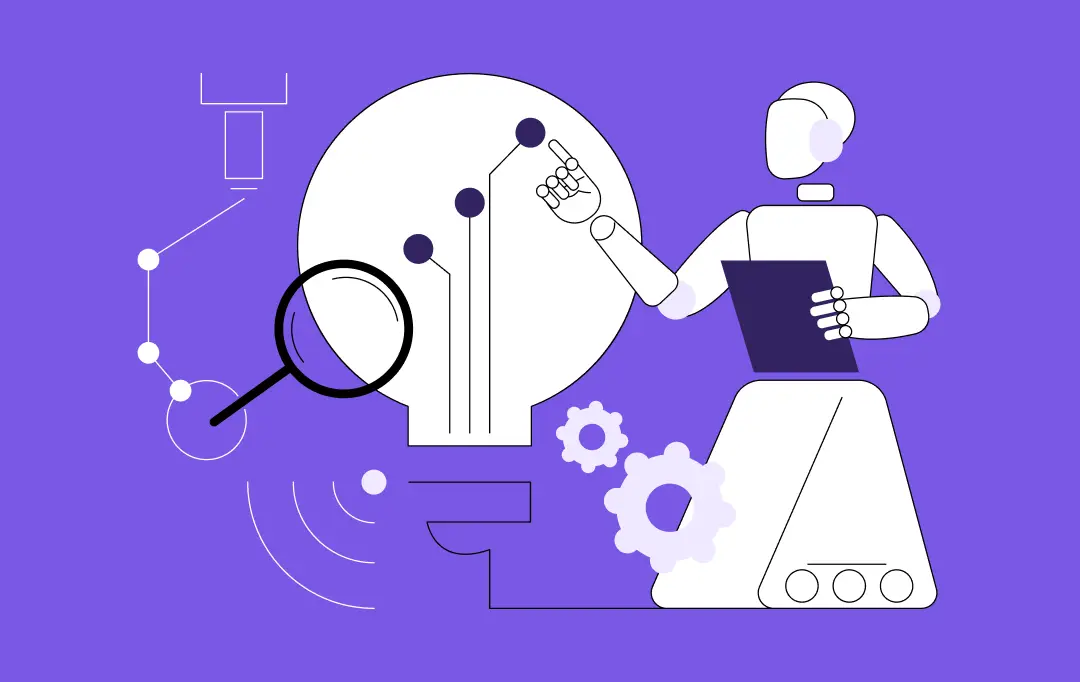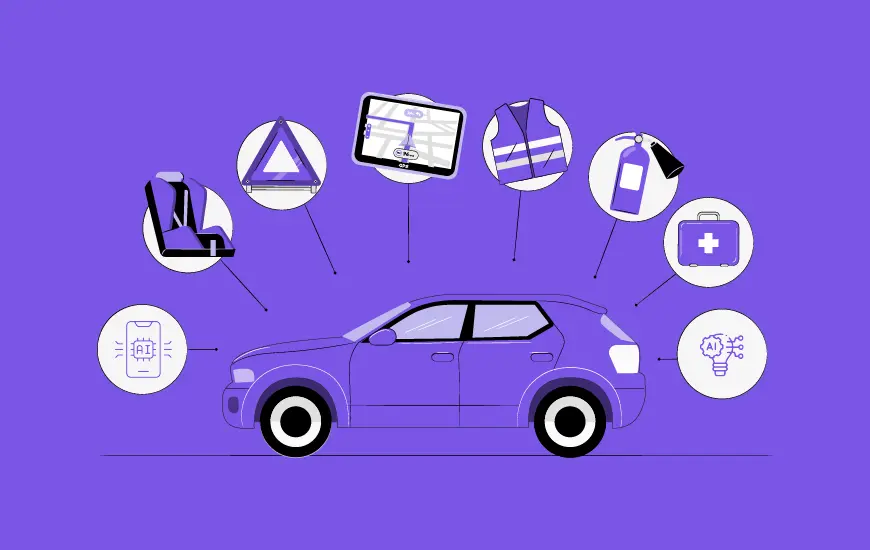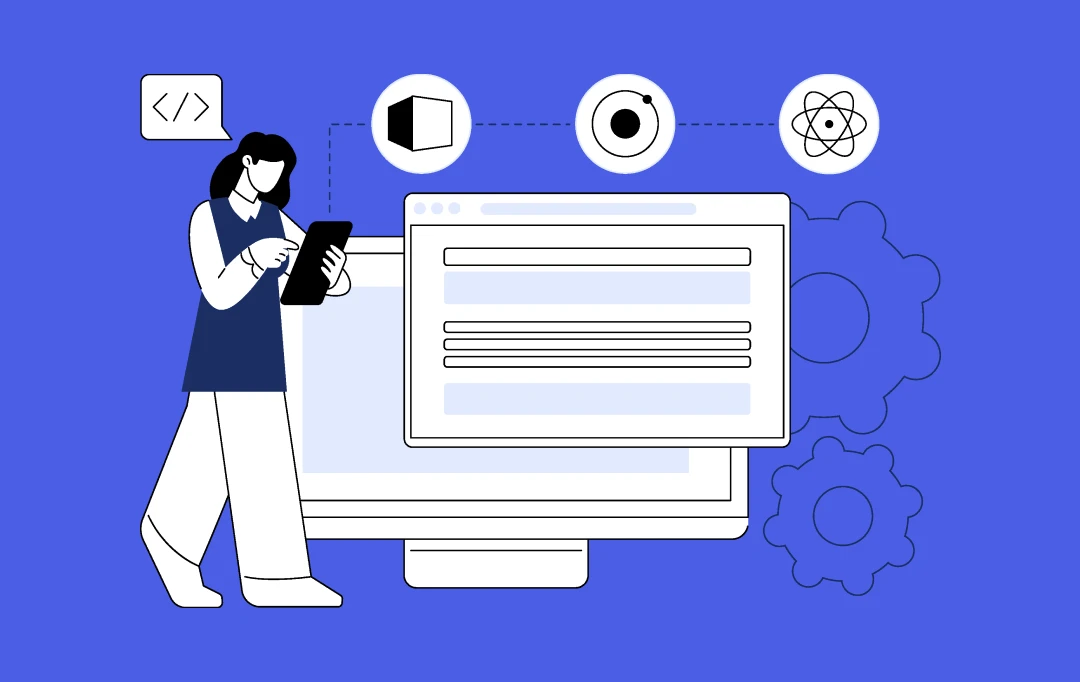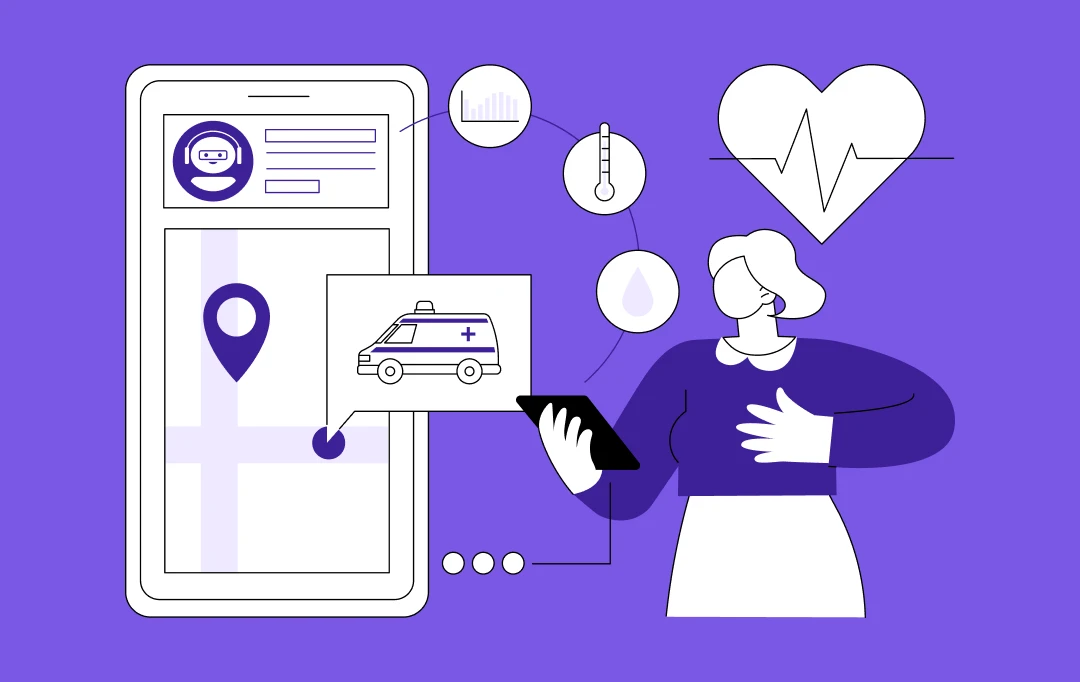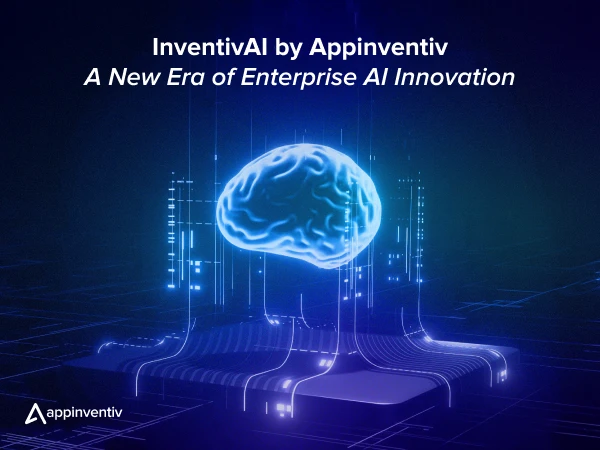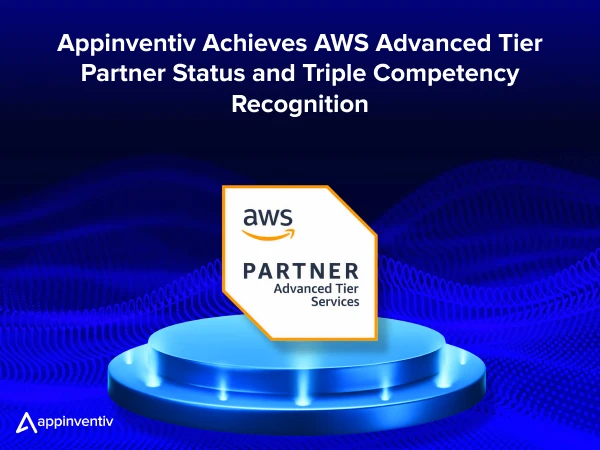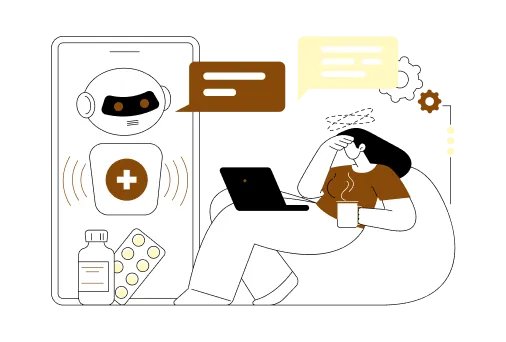- Why Medical Schools Can No Longer Delay AI Integration
- The Shifting Landscape Demands Change
- Operational and Pedagogical Impact
- The Clinical Readiness Imperative
- Deconstructing the Blueprint: What Your AI Integration Strategy Must Cover
- The Vision & Governance Foundation
- Technology, Infrastructure, and Data Architecture
- Curriculum and Pedagogical Alignment
- Faculty Capability and Change Management
- Measurement, ROI, and Continuous Improvement
- Ethics, Evidence, and Equity
- Benefits of AI Integration in Medical Education for Faculty, Administration & Students
- University and Faculty Perspectives: Real Voices from the Frontlines
- Real‑World Use Cases of AI in Medical Education with Examples of Schools Using It
- 1. Northwestern Medicine's Clinical AI Deployment
- 2. University of Miami Miller School of Medicine
- 3. UT Health San Antonio: Scaling Clinical Simulation
- Six Core Features of an AI‑Enabled Medical Education Ecosystem
- Challenges in Implementing AI in Medical Education and How to Overcome Them
- The "Black Box" & Trust Problem
- Algorithmic Bias and Health Equity
- Data Fragmentation and Security
- How to Build Your AI Integration Strategy in 2026: A 5-Step Action Plan for 2026
- Phase 1: Assess and Audit
- Phase 2: Govern & Plan
- Phase 3: Pilot and Train
- Phase 4: Develop Infrastructure
- Phase 5: Manage Change & Train Faculty
- Phase 6: Scale, Measure, & Iterate
- Future of AI in Medical Education: Why Should You Act Now
- How Appinventiv Can Help Implement AI for Medical Education
- FAQ
Key takeaways:
- Waiting until 2026 to formulate an AI strategy for medical schools is too late. The integration of AI in medical education and training demands immediate planning.
- The primary challenge isn’t just technology; it’s governance. A successful strategy must prioritize data privacy (HIPAA/FHIR), bias mitigation, and clear ethical frameworks.
- Leading institutions like the University of Miami, and UT Health are already deploying AI for curriculum, simulation, and administrative efficiency, proving tangible ROI.
- Gartner predicts that by 2028, over half of enterprise GenAI models will be domain-specific. For medicine, this means moving beyond generic tools to secure, validated, and medically-trained AI models.
The healthcare industry is experiencing unprecedented transformation driven by artificial intelligence, yet many medical schools remain stuck in 20th-century pedagogical frameworks. This disconnect creates a fundamental problem: institutions are training tomorrow’s physicians using yesterday’s methods, all while the tools these graduates will actually use in clinical practice are evolving at breakneck speed.
The stakes have escalated. Recent data from McKinsey & Company suggests that 85% of healthcare leaders from payers, health systems, and healthcare services and technology groups were exploring or had already adopted generative AI capabilities as of Q4 2024.
As 2026 approaches, the stakes for medical education are shifting under our feet. If your institution lacks a substantive AI integration strategy for medical schools, you risk falling behind; not gradually, but with speed. What’s even worse is that you will be producing graduates unprepared for the realities of modern medicine.
In short, the tools and expectations that once belonged to the future are now surfacing in the present. Medical schools that integrate artificial intelligence into their teaching, assessment and research processes will unlock major competitive advantages.
Interested in integrating AI in your medical school but facing questions around how to shift from experimentation to purposeful strategy: what does application of AI in medical education really look like? How do you make it work in your institution? And what returns can you expect?
Then this blog is for you. We have hand curated this blog for CTOs, Deans, and Provosts in the medical schools who need to move beyond curiosity to construction of an actionable AI integration strategy in medical schools.
In this blog, we will examine why the urgency is real, what the strategy must include, and how real‑world institutions are already treading this path. So without further ado, let’s get started:
As 85% of healthcare leaders turn to generative AI, it’s clear that AI is no longer a future trend; it’s the present. Let’s talk about how you can implement AI tools and training in your school today.
Why Medical Schools Can No Longer Delay AI Integration
The education sector is becoming increasingly data-driven, and AI is playing a pivotal role in transforming how we teach, assess, and prepare the next generation of healthcare professionals. Here are some compelling reasons why AI integration is imperative:
The Shifting Landscape Demands Change
You may think your curriculum and simulation labs are state‑of‐the‐art today but tomorrow’s learners expect more. Drastic improvements in student data availability, learning‑analytics tools and virtual simulation technologies are redefining what “prepared” means in healthcare education.
A recent report noted that in higher education, 45% of faculty were using AI tools in 2024 (up from 24% in 2023). If medical schools don’t keep pace, they risk misalignment with both student expectations and healthcare systems that are increasingly AI‑enabled.
Operational and Pedagogical Impact
For faculty and administrators alike, the increase in administrative burden and the need for more individualized student engagement create real pressure. An effective AI strategy for medical schools can relieve these pressures.
This helps automate routine tasks, surface early indicators of student risk, and enable educators to focus on high‑value interaction rather than form‑filling.
In addition, AI integration will help deliver personalized learning experiences, tailoring content and pacing to each student.
The Clinical Readiness Imperative
Finally, consider the translation of education into practice. As hospitals and clinics adopt AI tools for diagnostics, workflow optimisation and patient‑monitoring, medical schools must ensure their graduates are ready for that environment.
Virtual patient simulators powered by AI, as well as real‑time analytics of performance, are no longer fringe; they’re becoming core. Schools that wait risk preparing learners for yesterday’s world.
Deconstructing the Blueprint: What Your AI Integration Strategy Must Cover
A successful AI strategy is not just a technology upgrade. It is a comprehensive, six-pillar framework that touches every part of your institution. It simply means that when you plan to integrate AI in your universities to build your roadmap, you must focus on these critical components.
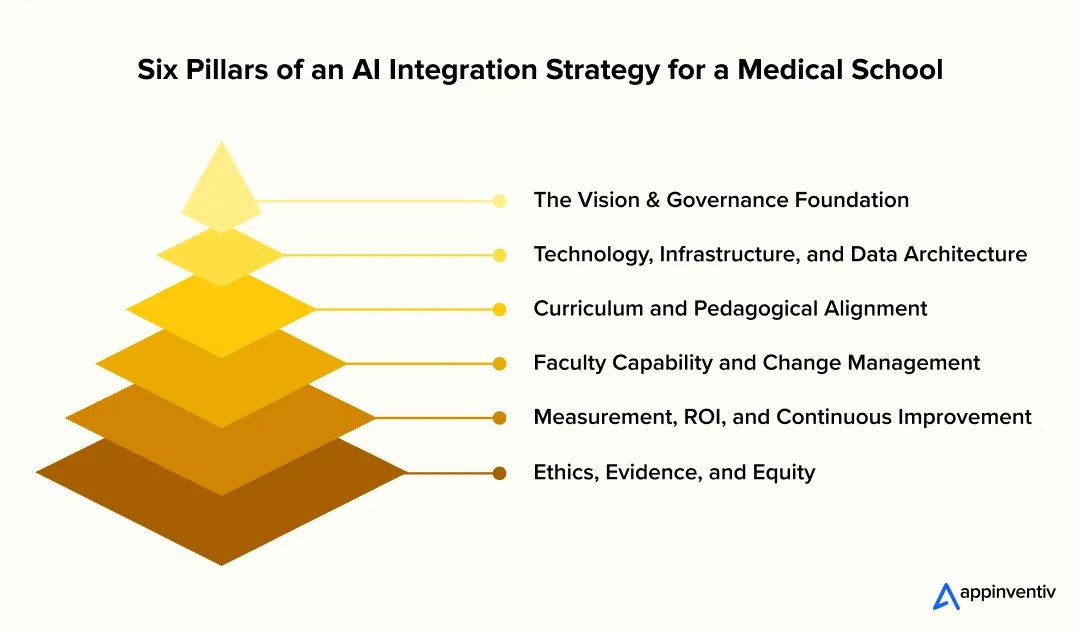
The Vision & Governance Foundation
This is the most critical, and most often overlooked, pillar. Before you start to implement AI in education for your medical business, you must define what success looks like.
- Define Your “Why”: What does an “AI-enabled healthcare education” mean for your institution? Is your primary goal to accelerate research? Improve diagnostic accuracy in training? Or reduce faculty burnout?
- Establish a Steering Committee: This cannot be a purely IT-led project. Your steering committee must include the Dean of Education, clinical department heads, faculty leaders, legal/compliance officers, and student representatives. This group champions the vision and dismantles siloes.
- Build the Ethical Guardrails: This is non-negotiable. Your governance framework must explicitly address data privacy regulations like HIPAA and GDPR, algorithm transparency, and bias mitigation.
Forrester’s “Predictions 2026” report warns that this will be the year AI “tests the heart of healthcare,” precisely because governance is lagging. You must have an AI governance plan for validating AI tools and a clear process for addressing “black box” algorithms.
Technology, Infrastructure, and Data Architecture
Your strategy lives or dies on its technical foundation. Your CTO needs to answer these questions now.
- Interoperability is Key: Your new AI tools must speak the same language as your existing systems. How will they integrate with your Learning Management System (LMS), your simulation lab software, and, crucially, your affiliated hospitals’ Electronic Health Record (EHR) systems? A fragmented tech stack creates friction and kills adoption.
- The Rise of Domain-Specific Models: Generic tools like ChatGPT are good but they are not medical experts. Thus, you must plan for a move toward Domain-Specific Language Models (DSLMs). It means AI trained on curated, validated medical literature and clinical data. This is essential for safety, accuracy, and building trust.
- Data Strategy as a Prerequisite: AI is fueled by data. Your institution’s data, from student performance analytics to de-identified clinical case logs, is your most valuable asset. You need a strategy to unify, cleanse, and secure this data so it can be used to train, validate and build your AI models.
Curriculum and Pedagogical Alignment
This is where the impact of AI integration in medical education becomes valuable for students.
- Embedding, Not Bolting On: Do not create a single, isolated “AI in Medicine” course and call it done. Instead, you must embed AI tools in medical education across the entire curriculum.
- Anatomy: Students use AI-powered VR/AR to explore 3D anatomical models.
- Pharmacology: AI simulations model drug interactions for a specific patient’s genetic profile.
- Diagnostics: Students compete against (or collaborate with) a diagnostic AI to interpret clinical images and lab results.
- Building New Competencies: Your ultimate aim should not only be to teach students how to use AI. You must build a complete “AI literacy” plan where students can question an AI’s output, understand its limitations, and recognize potential biases.
Faculty Capability and Change Management
Your faculty is the torch bearer of your educational mission. If they are not trained, trusted, and empowered, your strategy will fall flat.
The gap is staggering. A 2024/2025 analysis highlighted in PubMed Central noted that while above 86% of faculty understand the power of AI, a mere 12% report being “very familiar” with the technology.
It means your AI strategy must include a robust “train-the-trainer” program. This should not be just a 1-hour webinar on Generative AI in medical education. It should involve pedagogical workshops that show faculty how to use AI to design new assessments, automate grading rubrics, and, most importantly. It should also include how to guide students in using these tools ethically and effectively.
Measurement, ROI, and Continuous Improvement
How will you know if your multi-million dollar strategy is working? Your framework must define success metrics from day one.
- Student Outcomes: Are board scores improving? Is the time-to-competency in surgical skills decreasing?
- Faculty & Admin Efficiency: Are you reducing the hours faculty spend on administrative tasks? Is the admissions process more efficient?
- Research Output: Is your AI in research and development in medical education leading to more publications or grant-funded projects?
- Cost & Compliance: Are you demonstrating cost-effective AI strategies in medical education? Are you successfully mitigating bias and ensuring 100% data compliance?
Ethics, Evidence, and Equity
No AI strategy is complete without a dedicated focus on ethics, evidence, and equity. As AI becomes more integrated into medical education, institutions must proactively address questions such as:
- How do we ensure AI tools are free from bias and promote health equity?
- What frameworks are in place to validate the accuracy and reliability of AI-generated recommendations?
- How do we safeguard student and patient privacy in compliance with regulations?
Establishing regular bias audits, transparent validation processes, and a diverse oversight committee will help ensure responsible AI adoption.
Benefits of AI Integration in Medical Education for Faculty, Administration & Students
The benefits of integrating AI into medical education are not just limited to students. It is for faculty, administration, and the healthcare system as a whole. It helps move beyond the conventional methods and create a learning environment that adapts to the needs of both the individual and the institution. Let’s dive into some of the major benefits of AI in medical education.
| Benefit Category | How It Works in Practice |
|---|---|
| Personalized Learning at Scale | AI analyzes a student’s performance on practice questions and identifies their specific knowledge gaps (e.g., cardiovascular pharmacology). It then auto-generates a personalized study guide and new, targeted questions, moving beyond a one-size-fits-all curriculum. |
| Enhanced Clinical Skill Development | Students can engage with AI-driven virtual patients 24/7. These “patients” can present with thousands of case variations, complex comorbidities, and even challenging communication styles. This allows students to practice clinical reasoning and empathy in a safe, repeatable environment. |
| Faculty & Administrative Automation | Generative AI in medical education can be used to draft course syllabi, create first-pass assessment questions, and summarize narrative feedback for student evaluations. This reclaims hundreds of hours of faculty time, reducing burnout and redirecting effort toward mentorship. |
| Accelerated Research & Discovery | Artificial intelligence for healthcare and medical education allows student and faculty researchers to analyze massive datasets (genomic, proteomic, public health) in minutes, not months. AI tools can also synthesize thousands of research papers to identify trends and knowledge gaps. |
| Equitable Access to Resources | AI-powered tutors and question banks (like the one developed at the University of Cincinnati) provide high-quality, on-demand academic support to all students, helping to level the playing field and reduce reliance on expensive third-party test prep services. |
University and Faculty Perspectives: Real Voices from the Frontlines
The true impact of AI integration in medical education is best understood through the lens of institutions that have already begun the transformation. These experiences highlight how universities are reshaping teaching, research, and operations through intelligent systems.
Dr. Priya Singh, Dean of Clinical Education at a leading medical university, shares:
“Integrating AI into our clinical curriculum has given faculty a much clearer view of student performance across cohorts. Early detection of learning gaps allows us to intervene faster, personalize instruction, and enhance overall academic outcomes.”Dr. Alex Chen, Director of Digital Learning at a partner medical institute, adds:
“Our AI-powered virtual simulation lab has transformed how residents practice complex procedures. The ability to repeat high-stakes cases without patient risk, paired with real-time analytics, has significantly improved clinical readiness across departments.”
These institutional perspectives show that AI in medical & healthcare education isn’t a theoretical innovation. It’s a practical enabler helping universities deliver more adaptive, data-driven, and scalable healthcare training.
Real‑World Use Cases of AI in Medical Education with Examples of Schools Using It
The future of AI in medical education is not a distant dream. It has already arrived at pioneering institutions. They are not waiting for 2026; they are building the case studies we will all learn from. Here are some real-world examples of AI integration in medical education:
1. Northwestern Medicine’s Clinical AI Deployment
Northwestern Medicine in Chicago demonstrates how AI can help optimize the radiology reporting process, reducing time and improving efficiency.
- The Problem: Radiology reporting is a critical task, but it’s time-consuming and prone to delays.
- The AI Solution: Northwestern Medicine in Chicago developed a homegrown AI system for radiology reporting. The system was tested over a five-month period in 2024, analyzing nearly 24,000 reports, and comparing the efficiency and accuracy of AI-assisted and traditional report creation.
- The Result: With AI’s help, the radiograph report completion efficiency improved by an average of 15.5%. This AI solution helped reduce the time needed for report generation, while maintaining high clinical accuracy.
2. University of Miami Miller School of Medicine
Miami’s Miller School of Medicine provides a powerful example of using AI to solve a specific, high-friction problem.
- The Problem: Creating the Medical Student Performance Evaluation (MSPE), a critical document for residency applications, was a monumental administrative task. Faculty had to manually sift through and summarize years of narrative comments for each student.
- The AI Solution: The school developed and trained an AI tool to read and summarize thousands of narrative assessments, pulling out key themes and performance indicators.
- The Result: The AI generates a comprehensive summary in minutes. This draft is then reviewed and refined by a human. The impact of AI integration in medical education here is clear: it saves countless hours, reduces human error, and creates more consistent and objective evaluations for residency programs.
3. UT Health San Antonio: Scaling Clinical Simulation
Simulation is a cornerstone of modern medical training, but standardized patients (actors) are expensive and not scalable.
- The AI Solution: UT Health San Antonio has been a leader in using AI to create highly realistic, on-demand simulated patients.
- How it Works: Students log onto a computer and have a clinical encounter with an AI. They must ask the right questions, show empathy, and work through a differential diagnosis. The AI is programmed to respond as a real patient would, with a specific history, symptoms, and even personality.
- The Result: This provides students with limitless opportunities to practice their clinical skills, make mistakes in a safe environment, and receive immediate feedback. This is a prime example of machine learning for medical education directly improving clinical competency.
Six Core Features of an AI‑Enabled Medical Education Ecosystem
As you move from theory to implementation, your ultimate goal is to build a cohesive ecosystem. You need to build a system where everything is linked to one another, not just a collection of disconnected AI tools in medical education. This ecosystem should include:
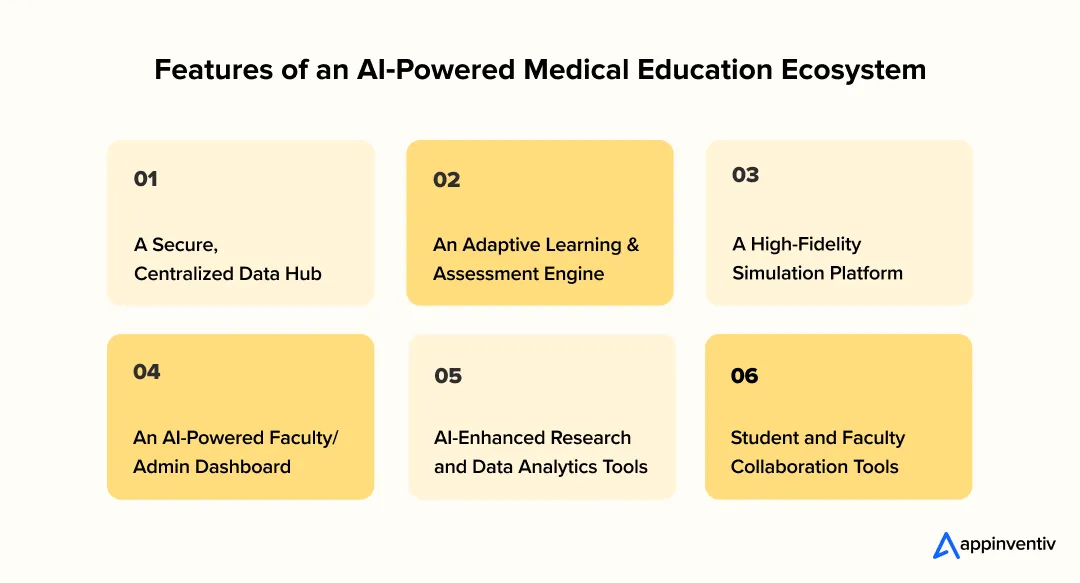
A Secure, Centralized Data Hub
This is the foundation of your AI powered medical education. It’s where de-identified student performance data and clinical case data are stored, governed, and made accessible for AI applications (in compliance with FHIR, HIPAA, etc.).
An Adaptive Learning & Assessment Engine
This is the “brain” of the student experience. It tracks individual progress and dynamically adjusts curriculum, content, and assessments to meet the learner where they are.
A High-Fidelity Simulation Platform
This is the “holodeck.” It combines VR/AR with advanced AI-driven virtual patients and surgical simulators to provide immersive, hands-on practice.
An AI-Powered Faculty/Admin Dashboard
This is the “control center.” It gives leadership a real-time view of student cohort performance, identifies at-risk students, and automates administrative tasks like curriculum mapping and accreditation reporting.
AI-Enhanced Research and Data Analytics Tools
Beyond the classroom, AI can support research and evidence-based learning. AI-driven analytics tools can analyze vast amounts of medical research data, uncover new insights, and generate reports. This helps students and faculty stay on top of the latest trends and breakthroughs in medical science.
Student and Faculty Collaboration Tools
AI can also improve collaboration across student groups and between students and faculty. Through intelligent matchmaking, collaborative platforms driven by AI can facilitate group work, simulate patient case discussions, and promote knowledge sharing. This not only enhances peer-to-peer learning but also strengthens the overall academic community.
Challenges in Implementing AI in Medical Education and How to Overcome Them
Integrating artificial intelligence in medical education is not without significant hurdles. Acknowledging and planning for them is the difference between success and a costly failure. Here’s a look at some of the main challenges you’ll likely face and how to overcome them:
The “Black Box” & Trust Problem
The Challenge: Many advanced AI models are “black boxes.” They provide a recommendation but cannot explain why. This is unacceptable in medicine, where “showing your work” is critical for training and patient safety.
The Solution: Your AI strategy must prioritize “Explainable AI” (XAI). Your governance framework must have a “human-in-the-loop” protocol for validating and overriding AI recommendations, ensuring AI is a co-pilot, not an autocrat.
Algorithmic Bias and Health Equity
The Challenge: This is one of the most dangerous challenges of AI in medical education. AI models are trained on data, and our historical data is filled with human biases. For instance, AI tools in US hospitals can consistently undervalue the education or health needs of Black patients.
The Solution: You must proactively audit your data and your algorithms. Your steering committee must include experts in health equity. When training students, you must specifically teach them to identify and question potential AI bias.
Data Fragmentation and Security
The Challenge: Medical school data is everywhere: in the LMS, in simulation software, in the registrar’s office, and in affiliated hospital EHRs. This data fragmentation makes it impossible to build effective AI models.
The Solution: Your AI integration strategy for universities must include a data governance plan. This means championing interoperability standards (like FHIR), investing in a unified data platform, and implementing ironclad security protocols to protect sensitive student and patient information.
How to Build Your AI Integration Strategy in 2026: A 5-Step Action Plan for 2026
You’ve seen the benefits, you understand the challenges, and now you’re ready to take the next step. But how do you actually start building an AI strategy that works for your medical school? Here’s a step-by-step approach to help guide you through the process of integrating AI in your educational systems.
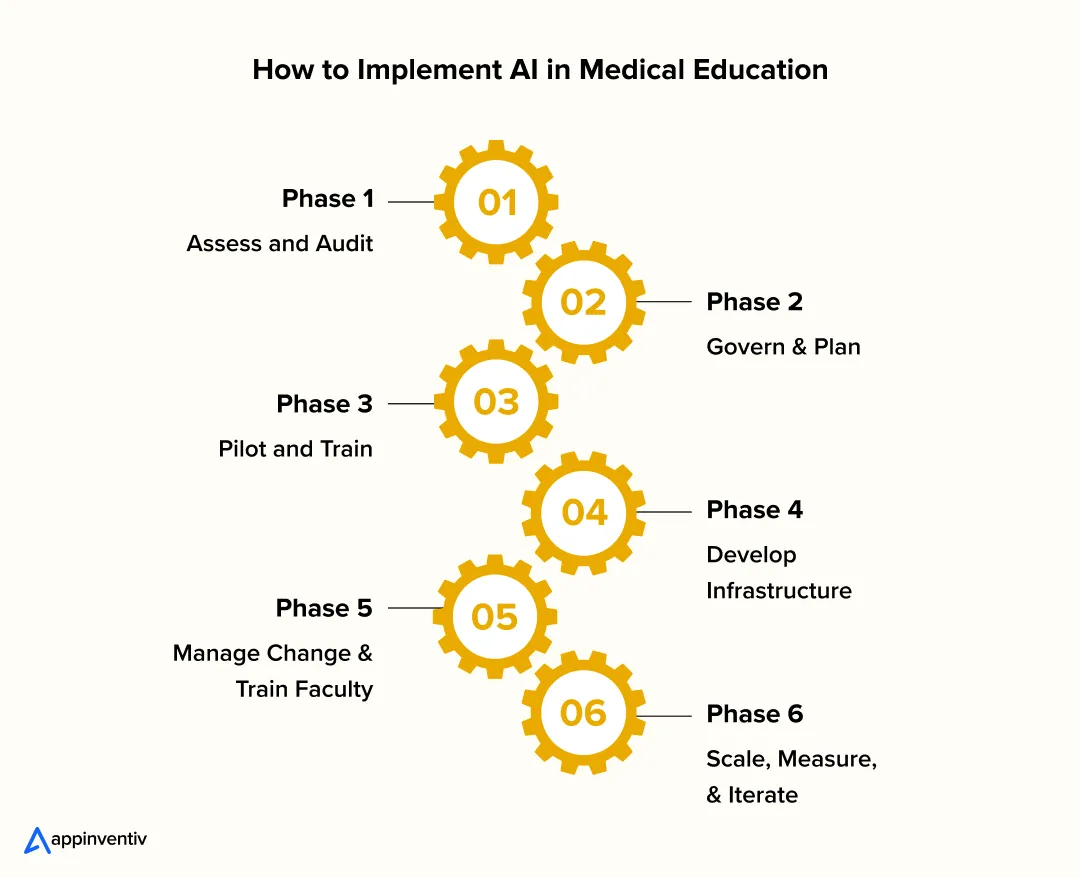
Phase 1: Assess and Audit
Conduct an honest audit. Where is your institution today?
- What AI elements exist in current curricula?
- What’s your technological infrastructure capacity?
- Who are early adopters on faculty?
- What regulatory or accreditation considerations apply?
Interview key stakeholders: faculty, students, IT leadership, compliance officers. Understand concerns and opportunities from multiple perspectives.
Research peer institutions ahead of you. What’s working? What failed? Learn from their experiences.
Based on these findings, develop your vision statement: What does a successful AI integration strategy for medical schools look like, specifically for your institution?
Phase 2: Govern & Plan
This is the stage where you need to draft your AI governance & ethics framework. This is your rulebook. Get legal and compliance to sign off on it.
The eventual goal of this step is to build your 3-year technology roadmap. Decide what to build, what to buy, and what to integrate. This is where you plan for your move to Domain-Specific Language Models (DSLMs).
Phase 3: Pilot and Train
Don’t attempt comprehensive implementation immediately. Start with 2-3 high-impact pilots. For examples:
- One department integrates AI into a specific course and measures learning outcomes
- IT implements AI-assisted grading in one large course and tracks time savings
- Simulation lab incorporates AI patient interaction in one program
Each pilot should be measurable. Define success metrics upfront. What would make you confident enough to scale? Run pilots with faculty willing in AI-enabled healthcare education.
Phase 4: Develop Infrastructure
While pilots run, IT develops infrastructure supporting broader adoption. This includes:
- Data governance policies
- AI platform procurement and integration
- Security and compliance frameworks
- Faculty support systems
This work continues during pilots but doesn’t block them. Don’t let perfect infrastructure planning delay getting started.
Phase 5: Manage Change & Train Faculty
This is not a phase; it’s a continuous journey. Without active and continuous involvement of your faculty, AI adoption can stall or face resistance. What should you do at this stage?
- Conduct monthly workshops on AI tools.
- Run internal conferences where early-adopter faculty share experiences.
- Recognize and reward faculty members who successfully integrate AI into their courses or research.
- Keep faculty members informed about the direction the institution is headed and how AI fits into the broader vision.
Change management is the often-forgotten factor but it determines the success or failure of your AI initiatives.
Phase 6: Scale, Measure, & Iterate
After pilots prove value, scale systematically. Integrate successful elements into core curricula. Hire AI developers to build secure and scalable AI systems for medical education.
Remember, implementing artificial intelligence in medical education is not one-time work. It will evolve as technology advances. Your strategy must include mechanisms for continuous refinement.
Future of AI in Medical Education: Why Should You Act Now
The convergence of AI, pedagogical shifts, and mounting healthcare demands means that inertia is now the single greatest risk to an institution’s future.
A strategic, well-governed AI integration for medical education is no longer optional. It is the engine of operational efficiency. It is the new frontier for pedagogical innovation. And it is the only way to prepare the next generation of physicians for the clinical reality they will inherit.
The future of AI in medical education will be defined by the institutions that build, govern, and scale these technologies with a clear-eyed vision. Those who wait for the dust to settle will find themselves competing for faculty, students, and prestige in a landscape that has been irrevocably changed without them.
The time to build your AI strategy was yesterday. The time to act is now.
How Appinventiv Can Help Implement AI for Medical Education
At Appinventiv, we don’t just build AI software; we architect MedEd-First solutions for the future of healthcare and education. Our team of 1600+ tech experts and 200+ AI Engineers understands the unique challenges of medical institutions. And this understanding has not come in 1 day. It is the result of our decade long industry expertise and lasting partnerships with healthcare organizations like DiabeticU, YouComm, Soniphi, Health-e-People, etc.
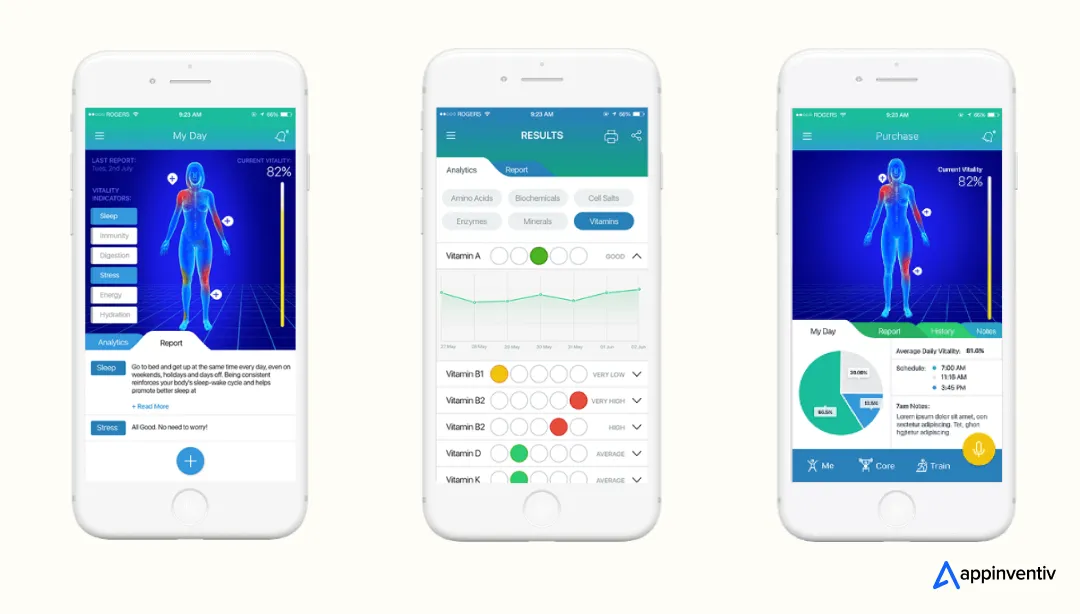
We specialize in helping you navigate the complex transition from traditional education methods to an AI advanced approach; supporting you every step of the way, from developing the initial strategy to executing a full-scale implementation.
Here is a roadmap of our custom AI development services for the healthcare and education sectors:
- Strategic Roadmapping: We partner with you to audit your existing infrastructure and build a practical, phased strategy for AI integration in medical schools.
- Custom AI & ML Development: We build bespoke, cost-effective AI strategies in medical education. From secure, HIPAA-compliant data platforms to custom machine learning for medical education models trained on your specific curriculum, we ensure that every solution is tailored to meet your institution’s unique needs.
- Data & Interoperability: Our AI experts excel in dismantling data silos. We build the FHIR- and API-based integrations that connect your LMS, simulation labs, and clinical systems into a single, intelligent ecosystem.
- Generative AI Solutions: We can help you build and deploy secure, private Domain-Specific Language Models (DSLMs). This ensures your institution’s data remains protected while giving your faculty and students the power of generative AI in medical education.
Don’t wait until 2026 arrives without a plan. Let’s build the future of medical education together.
FAQ
Q. How is Generative AI transforming medical education?
A. Generative AI in medical education is a game-changer. Beyond basic automation, it can:
- Create dynamic content: Generate unique patient case studies, exam questions, and personalized study plans on the fly.
- Power advanced simulations: Act as the “brain” for virtual patients, allowing for unscripted, natural language conversations about symptoms and history.
- Summarize complex research: Help students and faculty synthesize vast amounts of medical literature, accelerating research and evidence-based practice.
- Draft clinical documentation: Tools are now being used to listen to a patient encounter and produce a draft clinical note, a key skill for students to learn.
Q. How is AI transforming medical education overall?
A. AI is transforming medical education by shifting the model from “one-to-many” (a single lecture) to “one-to-one” (a personalized experience). It’s achieving this by:
- Personalizing learning: Using machine learning for medical education to identify individual student weaknesses and strengths, then adapting the curriculum.
- Automating low-level tasks: Freeing faculty from administrative burdens like grading and scheduling to focus on high-level mentorship.
- Making simulation scalable: Providing 24/7 access to virtual patients and procedures, allowing for limitless, safe practice.
- Improving assessment: Moving beyond multiple-choice questions to assess a student’s process and clinical reasoning within a simulated environment.
Q. Why should medical education integrate AI in 2026?
A. The year 2026 is a critical inflection point. Integration is no longer a future goal but an immediate necessity because:
- The Clinic is Already Using It: Graduates will be expected to use AI-driven diagnostic and administrative tools from day one of their residency.
- The Competency Gap is Widening: Schools that fail to teach AI literacy (including ethics and bias) will produce graduates who are unprepared for modern clinical practice.
- The Efficiency Demands It: To combat faculty burnout and rising costs, schools must adopt cost-effective AI strategies in medical education for automation and efficiency.
- Your Competitors Are: Leading institutions are already building AI into their core strategy, creating a significant competitive advantage in attracting top students and faculty.
Q. How does Appinventiv help with AI integration in medical education?
A. Appinventiv acts as your technical and strategic partner. We don’t offer a single, one-size-fits-all product. Instead, we help you build a custom, secure, and scalable AI integration strategy for universities. This includes:
- Building the data infrastructure (data lakes, interoperability layers using FHIR).
- Developing custom AI models for diagnostics, student assessment, or administrative automation.
- Creating secure, private Generative AI applications (DSLMs) so you can leverage the technology without risking data privacy.
- Integrating new AI tools seamlessly with your existing LMS, EHR, and simulation systems.
Q. How is Augmented Intelligence transforming medicine and medical education?
A. We prefer the term “Augmented Intelligence” over “Artificial Intelligence.” This concept is key to the role of AI integration in medical education. It frames AI not as a replacement for human doctors and educators, but as a collaborator that augments their abilities. In education, this means:
- For Students: AI acts as a 24/7 tutor and simulation partner, augmenting their ability to learn and practice.
- For Faculty: AI acts as a teaching assistant and research aid, augmenting their ability to manage large cohorts and analyze complex data.
- For Clinicians: AI acts as a co-pilot, flagging potential issues in an image or summarizing a patient’s history to augment their diagnostic and decision-making capabilities.


- In just 2 mins you will get a response
- Your idea is 100% protected by our Non Disclosure Agreement.

How Much Does It Cost to Build an AI App in Dubai?
Key takeaways: AI app costs in Dubai typically range from AED 80,000 for simple builds to AED 800,000+ for enterprise systems. Dubai is past AI experimentation, and not investing now means catching up later at higher cost. The real budget is driven by data, integrations, architecture, and compliance, not just app features. Hidden costs like…

How AI Tokenization is Enabling Secure and Transparent Asset Ownership in 2026
By 2026, AI tokenization has moved beyond early-stage experiments and pilot projects. Tokenizing real-world assets has become a serious commercial strategy for financial institutions, supply chain operators and technology-driven enterprises. A 2025 report by the World Economic Forum in collaboration with Accenture highlights tokenization as a key mechanism for value exchange in modern financial markets.…

13 Ways Generative AI is Transforming the Hospitality Industry
Key takeaways: The most mature applications of Generative AI for hospitality are in guest service, revenue management, marketing, and operations automation. Real value comes from integrating generative AI into hospitality operations and existing PMS, CRS, CRM, and POS systems, rather than using stand-alone tools. Successful programs treat Generative AI in hospitality as a product, incorporating…

